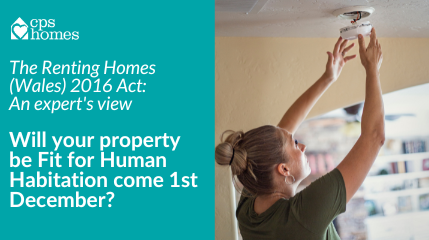
Is your property Fit for Human Habitation under the Renting Homes (Wales) Act 2016?
 The expert's view: Landlord advice from our Director of Operations, Nikki Lewis...
The expert's view: Landlord advice from our Director of Operations, Nikki Lewis...
The Renting Homes (Wales) Act 2016 gave Welsh Government the power to introduce The Renting Homes (Fitness for Human Habitation) (Wales) Regulations 2022, otherwise known as FFHH Regs.
They prescribe the 29 ‘matters and circumstances’ (see below) that must be considered when determining if a property is fit for human habitation, plus the requirements for carbon monoxide alarms, smoke alarms and electrical safety reports.
The 29 items are almost identical to the items considered under The Housing Health and Safety Rating System (HHSRS) – the risk assessment-based method local authorities use to determine housing conditions – but, crucially, FFHH does not replace HHSRS.
FFHH is just a process for landlords and contract-holders to follow to agree if the property is fit to live in. If they can’t agree, it’s for the courts to decide, though it’s hoped that won’t be the case, as Welsh Government want landlords and contract-holders to be able to decide it for themselves in order to lessen the load on the courts.
- If the carbon monoxide alarms, smoke alarms and electrical safety reports requirements aren’t met, the Regs make it clear that the property is not fit for human habitation.
- The 29 ‘matters and circumstances’ are less clear cut as they may be more subjective.
Welsh local authorities will still use HHSRS when inspecting properties. In some cases, a property will be fit under FFHH but the local authority might still take action under HHSRS. For example, a worn carpet causing a trip hazard won’t cause a property to be declared unfit for human habitation under FFHH, but a local authority may take enforcement action under HHSRS, especially if there’s an elderly person occupying.
The 29 ‘matters and circumstances’ to be considered when determining if a property is fit for human habitation
Damp, mites and mould or fungal growth
1. Exposure to house dust mites, damp, mould or fungal growths.
Cold
2. Exposure to excessively low temperatures.
Heat
3. Exposure to excessively high temperatures.
Asbestos and manufactured mineral fibres
4. Exposure to asbestos fibres or manufactured mineral fibres.
Biocides
5. Exposure to chemicals used to treat timber or mould growth.
Carbon monoxide and fuel combustion products
6. Exposure to—
- carbon monoxide;
- nitrogen dioxide;
- sulphur dioxide and smoke.
Lead
7. The ingestion of lead.
Radiation
8. Exposure to radiation.
Uncombusted fuel gas
9. Exposure to uncombusted fuel gas.
Volatile organic compounds
10. Exposure to volatile organic compounds.
Crowding and space
11. A lack of adequate space for living and sleeping.
Entry by intruders
12. Difficulties in keeping the dwelling secure against unauthorised entry.
Lighting
13. A lack of adequate lighting.
Noise
14. Exposure to noise.
Domestic hygiene, pests and refuse
15.—(1) Poor design, layout or construction such that the dwelling cannot readily be kept clean.
(2) Exposure to pests.
(3) An inadequate provision for the hygienic storage and disposal of household waste.
Food safety
16. An inadequate provision of facilities for the storage, preparation and cooking of food.
Personal hygiene, sanitation and drainage
17. An inadequate provision of—
- facilities for maintaining good personal hygiene;
- sanitation and drainage.
Water supply
18. An inadequate supply of water free from contamination, for drinking and other domestic purposes.
Falls associated with baths etc.
19. Falls associated with toilets, baths, showers or other washing facilities.
Falling on surfaces
20. Falling on a surface.
Falling on stairs etc.
21. Falling on stairs, steps or ramps.
Falling between surfaces
22. Falling from one surface to another (including falling from height).
Electrical hazards
23. Exposure to electricity.
Fire
24. Exposure to uncontrolled fire and associated smoke.
Flames, hot surfaces etc.
25. Contact with—
- controlled fire or flames;
- hot objects, liquid or vapours.
Collision and entrapment
26. Collision with, or entrapment of body parts in, doors, windows or other architectural features.
Explosions
27. An explosion at the dwelling.
Position and operability of amenities etc.
28. The position, location and operability of amenities, fittings and equipment.
Structural collapse and falling elements
29. The collapse of the whole or part of the dwelling including falling elements.
Let CPS Homes help
We're experts on The Renting Homes (Wales) 2016 Act and are helping landlords navigate through the changes. By instructing us to manage your property, we will...
- Work with you to put efficient processes in place well in advance of key dates for new legislation and regulations, ensuring you and your properties are compliant, safe and legal.
- Save you the cost of a Rent Smart Wales landlord licence and the hassle of ongoing training.
- Maximise your rental income by ensuring the property is always achieving its full potential.
- Provide you with your own representative within our Lettings and Accounts departments.
- Produce a FREE professional walkthrough video tour and photography as part of our standard marketing package.
- Place you on our VIP Investor list where you'll get priority access to pre-market investment properties before they're listed online.
- Provide you with peace of mind via our Client Money Protection (CMP) policy, professional indemnity insurance, and redress scheme membership.
To discuss CPS Homes taking over management of your property, contact our Senior Property Investment & Market Advisor, Rhys Owen, today via rhys.owen@cpshomes.co.uk or 02920 668585.
The information contained within this article was correct at the date of publishing and is not guaranteed to remain correct in the present day.



